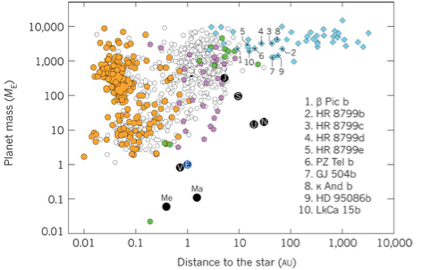(Figure from Pepe, Ehrenreich, & Meyer, 2014).
The goal of this work is to investigate the planet mass function as well as the oribital distributions of planets (and possible correlations between the two), as a function of host star mass. We believe this is one of the best ways to provide strigent tests of planet formation theory. Our main tools are large exoplanet imaging surveys which to date have been limited to finding gas giant planets at large orbital separations. We also develop parametric exoplanet population models for comparison to observations (as well as theory). Current views are summarized in a recent review (Gaudi, Christiansen, & Meyer). On-going projects include:
- Surface density distribution of gas giant planets as a function of stellar mass. See our recent paper concerning M dwarfs (M. Meyer et al. 2018) as well as our most recent paper (Meyer et al. in prep; cf. poster on FGK stars presented at the 20th Cool Stars meeting in Boston).
- Companion mass ratio distribution from planetary masses to brown dwarf companions as a function of stellar mass. See recent work on FGK stars published by Reggiani et al. 2016, and Meyer et al. (in prep; recent talk at ExoDem conference organized by the NASA Exoplanet Science Center).
- Statistical analysis of the SPHERE SHINE exoplanet survey as part of the SPHERE GTO Team (PI – J.-P. Bezuit) where we co-lead the Working Group on Statistical Analysis (Vigan et al. 2020; Desidera et al. submitted; Langlois et al. submitted).
- We are also involved in extending this work to close and wide binary star systems. as well as a new survey of B stars, and Y dwarfs.
- M dwarf exoplanet imaging survey with NIRCam on the James Webb Space Telescope: with Josh Schleider (GSFC), Chas Beichmann (JPL), and the NIRCam Exoplanet Team (PI -M. Rieke, U. Arizona).
- As part of this work, we are also involved in binary star research, such as the work of graduate student Matthew De Furio and undergraduate Nicholas Susemiehl.


